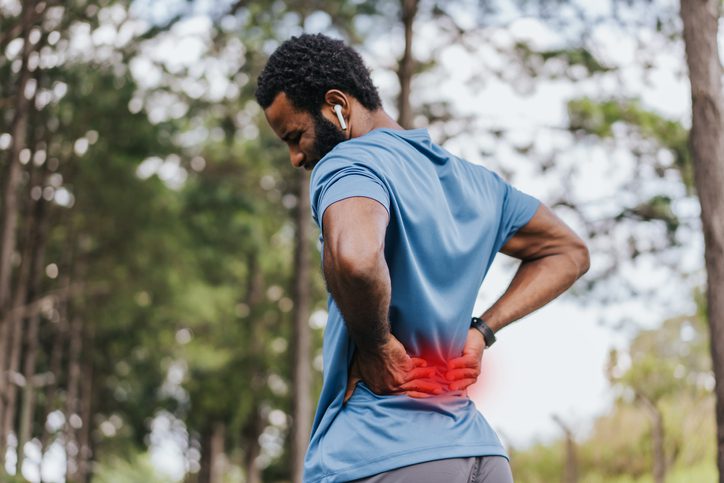Physicians face many challenges when people with alcohol use disorder (AUD) or substance use disorder (SUD) experience chronic pain. There’s a great need to provide adequate relief, but not so much that someone might experience a relapse. Knowing how to understand the root causes of pain and working with your provider are the best steps for successfully managing chronic pain in recovery.
Chronic Pain: You’re Not Alone
Johns Hopkins Medicine explains there are two types of pain:
- Acute. Usually caused by illness, inflammation, injury, recent surgery, or tissue damage. The pain usually ends after a week or two once the underlying cause is treated or resolved.
- Chronic. Pain that persists for months or even years beyond a typical recovery period.
Unfortunately, pain is a common problem. In 2023, the Centers for Disease Control and Prevention reported that an estimated 50 million adults in the U.S. experience chronic pain. The CDC states that “it’s a debilitating condition that affects daily work and life activities for many adults in the United States and has been linked with depression, Alzheimer disease and related dementias, higher suicide risk, and substance use and misuse.”
Additionally, the CDC indicates that approximately 17 million people have “high-impact chronic pain that results in substantial restriction to daily activities…with a higher prevalence among non-Hispanic American Indian or Alaska Native adults, adults identifying as bisexual, and adults who were divorced or separated.”
Johns Hopkins notes that many people with chronic pain enter the “terrible triad.” Because their condition interferes with daily life, work, and activities, they become “preoccupied with the pain, depressed, and irritable. Depression and irritability often leads to insomnia and weariness, leading to more irritability, depression, and pain.” Then, the urge to stop the pain often causes individuals to become drug-dependent, or engage in repeated surgeries or questionable treatments.
Why Chronic Pain Can Be Hard to Treat
Pain is completely subjective, which is why medical professionals find it difficult to assess an individual’s pain complaint. Some researchers even express that “pain is hard to understand from a scientific perspective” due to numerous factors, including a person’s relationship between mind and body, environmental influences, and even genetic makeup. To this point, recent studies involve families whose members have pain super-sensitivity—or conversely, high tolerances for pain—to determine if DNA code variances might have something to do with how a person’s pain receptors react.
Painkiller misuse is still high, and not simply from illicit use. Although many physicians have scaled back on opioids, medical marijuana and off-label usage of ketamine are often prescribed when patients request them.
What’s worse is that more medication doesn’t necessarily stop the pain, especially when certain drugs—such as NSAIDs or anti-inflammatories—have a ceiling effect, resulting in less pain relief. Each one of us has a different pain threshold (the point at which you first notice pain)and pain tolerance (the limit of pain you can stand). These variables change drastically due to AUD or SUD.
Additionally, people have a different pain experience depending on their underlying condition, so it’s crucial to have a strong understanding of how and why pain stems from this root cause. Some of the most common causes of chronic pain include:
- AIDS
- Arthritis/rheumatoid arthritis and osteoporosis
- Back pain, especially in the low back
- Cancer
- Gallbladder disease
- Headaches
- Fibromyalgia
- Multiple sclerosis
- Nerve damage and neuropathy
- Shingles
- Stomach ulcers
Managing Chronic Pain in Recovery
“A multidisciplinary approach to pain management is often required to provide the needed interventions to help manage the pain,” Johns Hopkins notes. “Pain management programs are usually done on an outpatient basis.” The organization suggests building a pain management rehabilitation team comprised of various medical professionals, including but not limited to:
- Anesthesiologists
- Case managers
- Occupational and physical therapists
- Neurologists and neurosurgeons
- Orthopedists and orthopedic surgeons
- Psychologists/psychiatrists
- Social workers
At Great Oaks Recovery Center, our board-certified medical specialists also recommend various types of non-invasive, holistic methods for managing chronic pain. These are good alternatives often accessible to many people. Talk with your providers about non-pharmacological options such as:
- Acupuncture
- Biofeedback
- Chiropractic care
- Cognitive behavioral therapy
- Cryotherapy
- Massage
- Mindfulness and meditation
- Myofascial release therapy
- Nerve blocking and injections
- Physical therapy
- Spinal cord stimulation
- Transcutaneous electrical nerve stimulator
- Yoga
Some pain management experts might also prescribe people in recovery specialized and monitored doses of over-the-counter pain remedies or site-specific pain pumps.
Discover Quality, Whole-Person Care at Great Oaks
At Great Oaks Recovery Center outside of Houston, Texas, our treatment philosophy incorporates effective evidence-based addiction treatment and long-lasting holistic recovery techniques. If you or a loved one has misused alcohol or substances in an attempt to manage chronic pain, we can help. We also provide detailed continuing care that establishes a clear path for your sobriety journey but also can be modified to fit changing needs.



